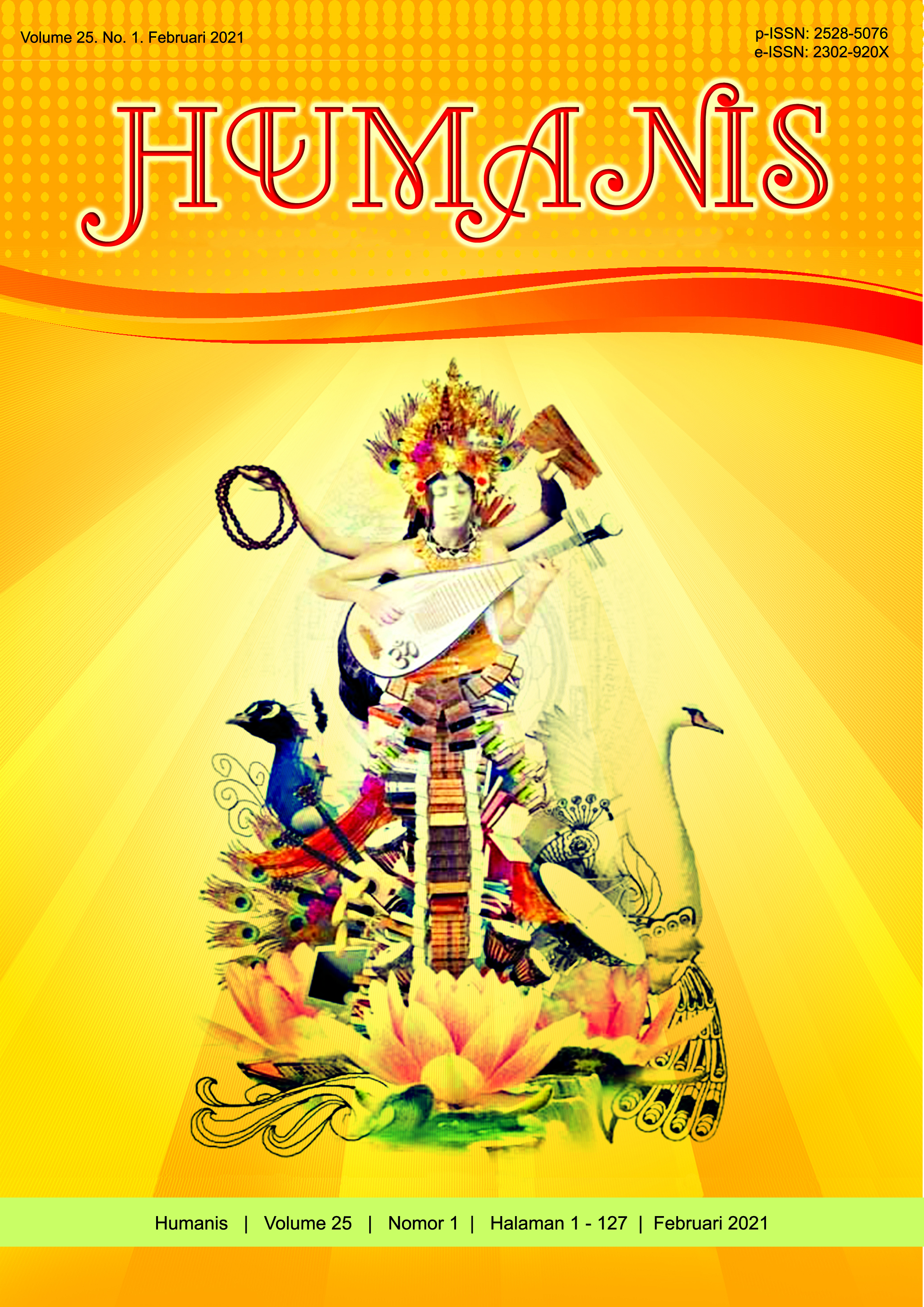Tari Baris Babuang pada Upacara Pegingsiran Jro Pingit di Desa Pengotan
Abstract
Bali is one of the islands that is very well known to foreign countries. Besides being famous for its natural beauty it is also known by the nickname of the Thousand Temples. It is known that the Balinese are usually inseparable from the sacred arts which are believed to complement the ceremony. Meanwhile in the village of Pengotan has a sacred dance that is the Baris Babuang dance. Baris Babuang is one element of universal culture that is part of the arts. Baris Babuang dance is danced by carrying banana fronds which can also be called the papah biu war. This research focuses on two things, namely the Babuang Baris Dance Function at the Pegingsiran Jro Pingit ceremony in Pengotan Village and the Meaning of the Babuang Baris Dance at the Pegingsiran Jro Pingit ceremony in Pengotan Village. The purpose and objective of this research is to find out the function and meaning of the implementation of the Babuang Baris Dance at the Jro Pingit ceremony. Then the authors use the Functional Theory of B. Malinowski and the ceremonial theory of William Robertson Smith to help strip the results of the research. This study uses qualitative methods to describe an event or phenomenon that occurs in a research subject such as behavior, perception, motivational action holistically and analyzed by collecting data that has previously been recorded besides audio visual recording, then recorded again in the recapitulation sheet then processed in the form of scientific writing. The results of this study state that, the function of Babuang Row Dance in relation to public trust, functions as a reinforcement of solidarity between citizens and the meaning of Babuang Row Dance to invoke safety, the meaning of kinship meaning the symbol of harmonization.
Downloads
References
Hasan,Abd.Rohman,(2018 Makna Tari Bucerai Dalam Pesta Perkawinan Di Desa Rantau Pandan Kecamatan Rantau Pandan Kabupaten Bungo Provinsi Jambi. E-Jurnal SedDra TaSik Vol 7, No 1 (2018).
Hendra,Doni Febri, (2018), Tari Inla Membangkitkan Nilai Spiritualitas Manusia Dengan Pendekatan Etnokoreologi,Jurnal Pendidikan dan kajian Seni, Fakultas Keguruan dan Pendidikan Seni Unoversitas Sultan ageng Tirtayasa. Vol 3, No 2 (2018).
Hidayati, Ratih Kurnia, (2016), Makna Tari Bajidor Kahot Ditinjau Dari Teori Semiotika Roland Barthes, Jurnal Ilmu Komunikasi Universitas 17 Agustus 1945.Vol2, No 2 (2016).
Iryanti, V.Eny, (2000), Tari Bali Sebuah Telaah Historis,(Bali Dance : A Historical Reasearch), Harmonia Jurnal Of Arts Research and education.Vol 1, No 2 (2000).
Jayanti, Suci Ramanda, (2019), Makna Tari Kejai Dalam Upacara Pesta Perkawinan Di Desa Topos Kecamatan Topos Kabupaten Lebong Provinsi Bengkulu.E-Jurnal SedDra TaSik, Vol 7, No 4(2019).
Kardji, I Wayan.(2010). serba-serbi tari baris antara fungsi dan profane: Jurnal ISI.Denpasar.ac
Kartiani, Ni Luh Desmi, Arshiniwati, Ni Made, Suminto, (2018), Bentuk Dan Fungsi Tari Baris Buntal, Desa Pakraman Pengotan, Kabupaten Bangli. Jurnal ilmiah mahasiswa program studi pendidikan seni drama,tari dan music.Vol 4, No 1 (2018).
Koentjaraningrat. 1979. Teori-teori Struktural Fungsional di Inggis. Diktat Teori Antropologi, F.S.U.I. Jakarta
Marlina, Leni, Supadmi, Tri, Lindawati, (2017), Fungsi Tari Dan Makna Gerak Tari Tradisioanal Landok Sampot Di Desa Lawe Sawah Kecamatan Kluet Timur Kabupaten Aceh Selatan,Jurnal Ilmiah Mahasiswa Pendidikan Seni, Drama, Tari & Musik.Vol 2, No 3 (2017).
Muliartini, Ni Nyoman, 2017, Eksistensi Tari Baris Idih-Idih Di Desa Pakraman Patas,Desa Taro, Kecamatan Tegallalang,Kabupaten Gianyar,Jurnal Penelitian Agama Hindu. Vol 1, No 1 (2017).
Nofitri, Misselia, 2015, Bentuk Penyajian Tari Piring Di Daerah Guguak Pariangan Kabupaten Tanah Datar. Jurnal Ekspresi Seni, Vol 17, No 1, (2015).
Rokhim, Nur, 2013, Makna Simbolik Tari Reyog Gembluk Tulungagung,GELAR: Jurnal Seni Budaya. Vol 11, No 2 (2013).
Sama, I Nyoman. 2017. Keterampilan Seni Tari Sebagai Media Pendidikan Karakter Anak di Bali. Prossiding, Univesitas Ngurah Rai, Denpasar.
Taib, Muhammad Fazli, 2014, Non-Formal Education As Culture Transformation Agent Towards The Development Of Clasical Court Dance In Yogyakarta, Indonesia. Internasional Journal Of Education and Research Vol 2, No 5 (2014.)


















